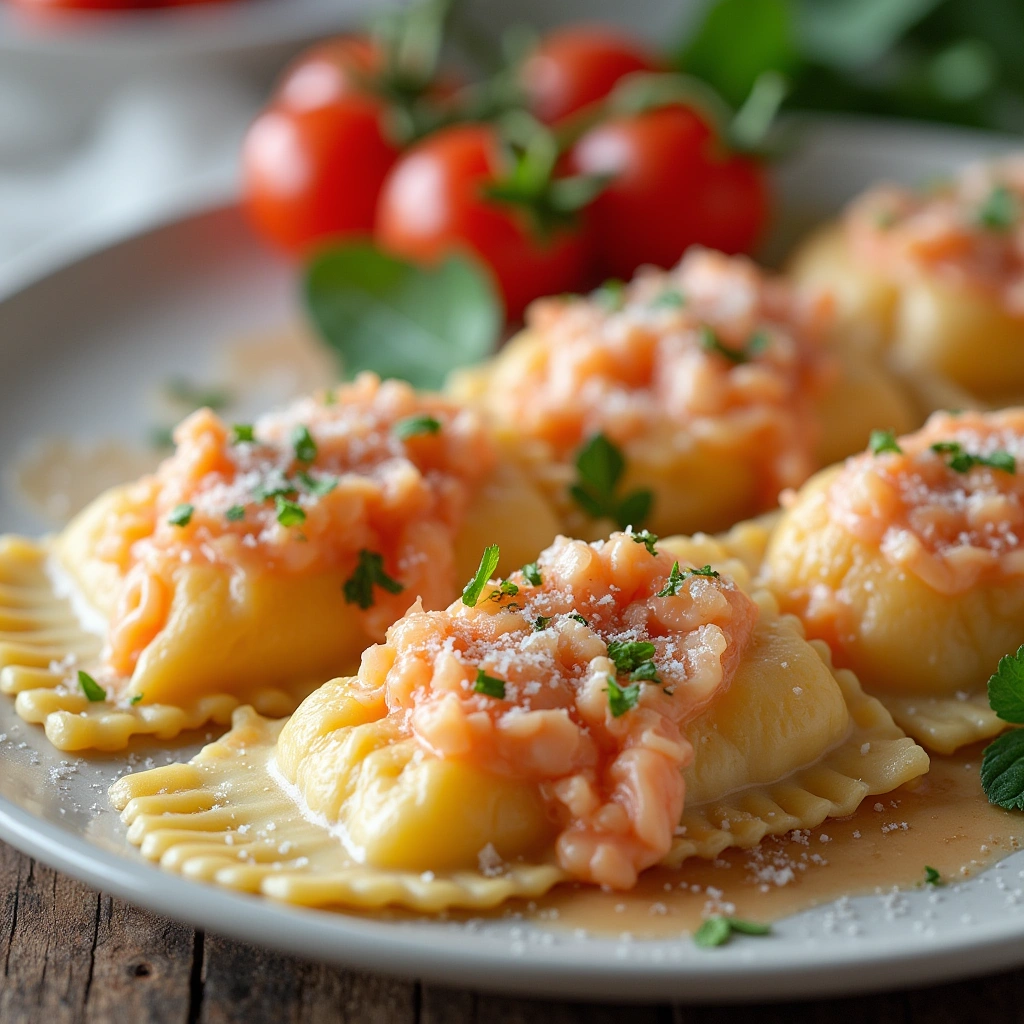Introduction and Preparation Basics for Frozen Lobster Ravioli
Introduction to Frozen Lobster Ravioli
Frozen lobster ravioli is a convenient gourmet delight that allows home cooks to enjoy the luxurious flavors of a fine dining dish without the need for extensive preparation. These pre-made pasta pockets, filled with tender lobster and complementary ingredients, are perfect for busy individuals or those looking to impress guests with minimal effort. Whether you’re preparing a weeknight dinner or hosting a special occasion, frozen lobster ravioli delivers restaurant-quality flavor with ease.
Its popularity lies in its simplicity—there’s no need to make pasta dough or prepare a lobster filling from scratch. With just a few steps, you can transform this ready-made product into a stunning dish by pairing it with the right sauce and presentation techniques. This article will guide you through selecting the best frozen lobster ravioli, preparing it with various cooking methods, and enhancing it with complementary sauces and garnishes.
Table of Contents
Choosing the Right Frozen Lobster Ravioli
Selecting high-quality frozen lobster ravioli is essential to achieving the best results. When shopping, consider the following factors:
- Ingredient Quality: Look for ravioli made with fresh lobster meat and avoid brands that rely heavily on fillers or artificial flavors.
- Reputable Brands: Opt for trusted brands with positive reviews or those specializing in seafood products. These often offer a better balance of flavor and filling-to-pasta ratio.
Examine the label carefully for details like the percentage of lobster meat in the filling. Higher lobster content ensures a more authentic taste. Some premium options may also include complementary flavors like herbs or cheeses that elevate the dish.
Proper storage is equally important. Keep frozen ravioli in its original packaging in the freezer until ready to cook. Most products have a shelf life of 6–12 months, but for the freshest taste, use them within a few weeks of purchase.
Preparation Basics Before Cooking frozen lobster ravioli
Preparing frozen lobster ravioli begins with understanding whether to thaw or cook them directly from frozen.
- Thawing: Thawing allows for more even cooking and reduces the risk of uneven textures. Place the ravioli in the refrigerator for a few hours or overnight.
- Cooking from Frozen: If you’re short on time, most frozen lobster ravioli can be cooked directly. Adjust cooking times slightly to account for the frozen state.
You’ll need a few essential tools for the process:
- A large pot for boiling water.
- A strainer or slotted spoon for handling ravioli gently.
- A nonstick pan for sautéing or searing.
- A steamer basket if you’re opting for steam cooking.
Avoid overcrowding the pot or pan, as this can lead to uneven cooking or cause ravioli to stick together. Cook in small batches if necessary, ensuring each piece has ample space to move freely.
Step-by-Step Cooking Instructions for Frozen Lobster Ravioli
Boiling Method
Boiling is the most common and straightforward method for cooking frozen lobster ravioli.
- Fill a large pot with water and bring it to a gentle boil. Add a generous pinch of salt for seasoning.
- Drop the frozen ravioli into the boiling water carefully, ensuring they do not stick together. Stir gently with a slotted spoon.
- Cook for 3–5 minutes, or until the ravioli float to the surface, indicating they’re done.
- Remove the ravioli with a slotted spoon and transfer them to a plate or toss them directly into your prepared sauce.
Tips: Avoid overcooking, as the delicate lobster filling may burst. Add a drizzle of olive oil after cooking to prevent sticking.
Pan-Searing Option
For a slightly crispy exterior and added flavor, pan-searing is an excellent choice.
- Pre-cook the ravioli by boiling them for 2–3 minutes until they are just tender. Drain and pat dry with a paper towel.
- Heat a nonstick skillet over medium heat with 1–2 tablespoons of butter or olive oil.
- Add the ravioli in a single layer and cook for 1–2 minutes on each side until golden and crispy.
- Serve immediately, garnished with fresh herbs or grated Parmesan.
Ideal for: Leftover or reheated ravioli for a texture upgrade.
Steam Cooking for Gentle Flavor
Steaming is a delicate method that preserves the lobster filling’s flavor and texture.
- Set up a steamer basket over a pot of simmering water.
- Arrange the frozen ravioli in a single layer in the basket, ensuring they do not overlap.
- Cover and steam for 8–10 minutes, checking occasionally for doneness.
- Serve with a light sauce like lemon butter to highlight the subtle flavors.
Advantages: Perfect for avoiding overly soft pasta or soggy fillings.
Microwave Preparation (Quick Fix)
The microwave is a fast alternative but requires careful attention to prevent overcooking.
- Place the frozen ravioli in a microwave-safe dish and add a splash of water to create steam.
- Cover the dish with a microwave-safe lid or plastic wrap, leaving a small vent.
- Microwave on medium power for 2–3 minutes. Check for doneness and continue in 30-second intervals if necessary.
- Drain any excess water and toss with sauce before serving.
Warning: Overcooking can lead to dry or chewy ravioli, so monitor closely.
Enhancing Frozen Lobster Ravioli
Creating Complementary Sauces
Creamy Alfredo or Bisque Sauce
A creamy Alfredo or bisque-style sauce adds a luxurious touch to frozen lobster ravioli.
- Ingredients: Combine 1 cup of heavy cream, 1/2 cup of seafood stock, 2 tablespoons of butter, and 1/4 cup grated Parmesan cheese.
- Preparation: In a saucepan, melt the butter over medium heat. Stir in the seafood stock and let it simmer for 2–3 minutes. Slowly add the heavy cream, whisking constantly to prevent curdling. Simmer the mixture until it thickens slightly, then stir in the Parmesan cheese until melted and creamy.
- Optional Enhancements: Add a pinch of smoked paprika or fresh tarragon for extra depth.
Lemon Butter Sauce
Lemon butter sauce provides a light and refreshing contrast to the richness of lobster ravioli.
- Ingredients: 4 tablespoons of unsalted butter, 2 tablespoons of freshly squeezed lemon juice, 1 teaspoon of lemon zest, and a pinch of salt.
- Preparation: Melt the butter in a skillet over medium heat. Stir in the lemon juice and zest, whisking to combine. Cook for 1–2 minutes, then season with salt.
- Pairing Notes: Finish with fresh parsley or chives for added freshness.
Garlic Herb Olive Oil Sauce
For a lighter, healthier option, garlic herb olive oil sauce is a simple yet flavorful choice.
- Ingredients: 3 tablespoons of olive oil, 2 minced garlic cloves, 1 teaspoon dried Italian herbs, and red pepper flakes to taste.
- Preparation: Heat olive oil in a skillet over low heat. Add garlic and cook until fragrant (about 1 minute). Stir in Italian herbs and red pepper flakes. Toss cooked ravioli in the sauce to coat evenly.
- Pro Tip: Garnish with grated Parmesan and crushed nuts for added texture.
Adding Garnishes and Side Dishes
Garnishes:
- Parmesan Cheese: Freshly grated Parmesan enhances the creamy and nutty flavors of ravioli dishes.
- Microgreens: These add a burst of color and subtle earthy notes.
- Lemon Zest: A sprinkle of lemon zest brightens up the dish, especially with butter-based sauces.
Side Dishes:
- Garlic Bread: A classic accompaniment that adds crunch and complements the richness of ravioli.
- Salads: Light salads with arugula, mixed greens, or citrus vinaigrette provide a refreshing contrast.
- Sautéed Vegetables: Asparagus, zucchini, or spinach work beautifully to balance the flavors of the meal.
Tips for Serving and Presentation
- Plating Techniques:
- Use a clean, white plate or shallow serving bowl to highlight the vibrant colors of the ravioli and sauce.
- Arrange ravioli neatly in a circle or fan pattern for a professional touch.
- Adding Aesthetic Appeal:
- Drizzle sauce artistically around the plate rather than pouring it all over. This ensures a clean, elegant look.
- Garnish strategically—add a small pile of microgreens or a sprinkle of Parmesan to the center of the dish for visual focus.
- Serving Tips:
- Warm the plates before serving to keep the ravioli and sauce at the perfect temperature.
- Use a small ladle to apply sauce evenly, ensuring that each ravioli is coated without drowning the dish.
Troubleshooting Common Issues
- Preventing Ravioli from Sticking Together:
- Use a large pot of water and stir gently after adding ravioli to ensure they don’t clump.
- Toss cooked ravioli with a small amount of olive oil if not serving immediately.
- Dealing with Broken or Leaking Ravioli:
- Avoid rapid boiling, as it can cause ravioli to burst. Use a gentle simmer instead.
- If ravioli break, strain carefully and plate delicately to maintain presentation.
- Adjusting Cooking Time:
- For smaller ravioli, reduce cooking time by 1–2 minutes.
- Larger or thicker ravioli may need an additional 1–2 minutes to cook thoroughly.
FAQs About Preparing Frozen Lobster Ravioli
Should I defrost frozen ravioli before cooking?
Not necessarily. Most frozen lobster ravioli can be cooked directly from frozen. However, defrosting in the refrigerator for a few hours can help ensure even cooking and reduce the risk of breaking.
Can I cook frozen ravioli in a slow cooker or air fryer?
While unconventional, ravioli can be cooked in a slow cooker by layering them with sauce and cooking on low for 2–3 hours. For an air fryer, pre-cook the ravioli by boiling, then crisp them in the air fryer for 3–5 minutes at 375°F.
How do I know when the ravioli is fully cooked?
Cooked ravioli will float to the surface of the water, and the pasta will feel tender when pressed with a fork.
What are some quick sauces for busy nights?
Brown butter, lemon butter, and garlic olive oil sauces are quick, easy, and flavorful options that can be prepared in under 10 minutes.
Can I refreeze partially thawed lobster ravioli?
It’s not recommended, as refreezing can affect the texture and taste of the ravioli. Cook and consume thawed ravioli within a day for the best results.

